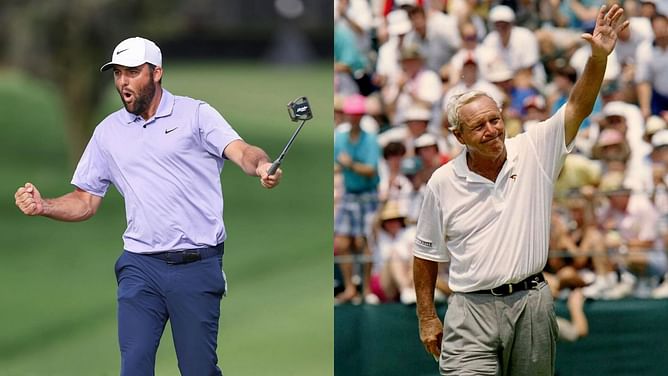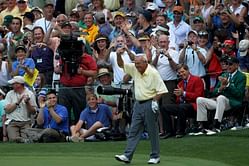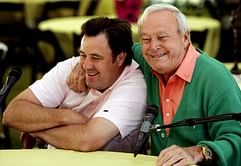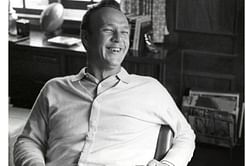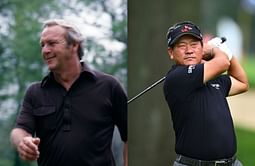Arnold Palmer: A Brief Biography
- Arnold Palmer's Early Life and Background
- Arnold Palmer's Amateur Career
- Arnold Palmer's Professional Career
- Arnold Palmer's Playing Style
- Arnold Palmer's Caddie
- Arnold Palmer's Golf Journey
- Arnold Palmer's Achievements
- Arnold Palmer's Majors
- Arnold Palmer's Awards and Honors
- Arnold Palmer's Net Worth
- Arnold Palmer's Ventures
- Arnold Palmer's Assets
- Arnold Palmer’s Family
- Arnold Palmer's Wife
- Arnold Palmer's Cars
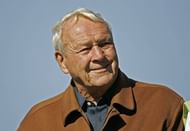
Arnold Palmer's Early Life and Background
Born in the middle-class steel mill town of Latrobe, Pennsylvania, on September 10, 1929, Arnold "The King" Palmer was the son of Doris (Morrison) and Milfred Jerome "Deacon" Palmer. Palmer's father, the head professional and greenskeeper at Latrobe Country Club, taught him the game, and so young Palmer was able to see his father tend to the course.
Arnold Palmer's Amateur Career
Palmer received a golf scholarship to Wake Forest College, but he left after learning of his close friend Bud Worsham's passing. Palmer then joined the US Coast Guard, serving for three years from 1951 to 1954.
He constructed a nine-hole course and had time to continue honing his game at the Coast Guard Training Center in Cape May, New Jersey. Palmer returned to college and resumed his golf competition once his military term expired.
After winning the U.S. Amateur in Detroit in 1954, Palmer decided to become a professional in November of the same year. As per him, this victory turned out to be life-changing and gave him confidence to "compete at the highest level of the game."
In response to questions from reporters about the identity of the young golfer who was hitting divots on the practice tee, 54-time professional win champion Gene "the machine" Littler responded, "That's Arnold Palmer. He's going to be a great player someday. When he hits the ball, the earth shakes."
Palmer left his career as a paint salesman to compete in the Waite Memorial tournament in Shawnee, Pennsylvania, after winning the U.S. Amateur. There, he met Winifred “Winnie” Walzer, the woman who would become his future wife.
Arnold Palmer's Professional Career
In 1955, Palmer's rookie season brought him his first tour victory, taking home $2,400 for winning the Canadian Open. Golf gained its current level of popularity in part because of his charm, which helped to make the sport a captivating TV spectacle in the 1950s and 1960s.
His first significant tournament victory at the 1958 Masters Tournament, where he took home $11,250, cemented his status as one of golf's biggest stars, and by 1960, he had become the first client of renowned sports agent Mark McCormack.
Palmer's amazing marketability made him a celebrity and gained him a fan club called "Arnie's Army." According to McCormack, there were five reasons Palmer was able to enjoy these benefits and many more, including his attractiveness, his relatively humble upbringing, his risk-taking and emotional style of play, his involvement in several thrilling finishes in early televised tournaments, and his affability.
Many people credit Palmer with establishing the Open Championship (British Open) as a fixture among American players. Due to The Open's significant travel needs, comparatively modest prize, and links course design, which is drastically different from most American courses, very few American pros had traveled to compete in the tournament prior to Ben Hogan's 1953 victory. In his attempt to become a top American golfer, Palmer aimed to follow in the footsteps of his predecessors, Ben Hogan, Sam Snead, and Bobby Jones.
In 1960, Palmer made his first trip to Scotland to play in the British Open. Palmer, who had already won the Masters and the US Open that year, was attempting to match Hogan's 1953 triple-major win in a single year. Palmer shot 70-71-70-68 in what he considered to be his four greatest rounds ever, but he lost by one stroke to Kel Nagle.
His victories at the Open the following year in the early 1960s persuaded many American pros that traveling to Britain would be worthwhile. This also guaranteed Palmer's reputation among British and European supporters in addition to American ones. His participation in the Open Championship "was the catalyst to truly internationalize golf," as per Keith Pelley, CEO of the European Tour.
Palmer's greatest years occurred between 1960 and 1963, during which he won 29 PGA Tour events in four seasons, including five major championships. He received the Hickok Belt in 1960 as the best professional athlete of the year and the "Sportsman of the Year" title from Sports Illustrated magazine.
In 1967, he became the first person to earn $1 million in career earnings on the PGA Tour. Although Jack Nicklaus and Gary Player had established a substantial lead in their battle by the late 1960s, Palmer staged a comeback in 1971, winning four events on the PGA Tour, winning one every year from 1955 to 1971.
Palmer was one of the big names that contributed to the success of the Senior PGA Tour (now known as PGA Tour Champions), having been eligible for it since its inaugural season in 1980. Throughout the tour, he won ten events, five of which were senior majors.
In England, Palmer was the winner of the inaugural World Match Play Championship. Originally, McCormack planned the event to highlight his group of players. One of the most important collaborations in sports marketing history was theirs, and because of his popularity with sponsors and the general public, Palmer continued to be one of the highest paid golfers long after he stopped winning championships. He received the Presidential Medal of Freedom in 2004.
On October 13, 2006, he announced his retirement from tournament golf after pulling out of the Administaff Small Business Classic on the Champions Tour after four holes because he was not happy with his play. He didn't keep score, but he played the last few holes.
Palmer passed away on September 25, 2016, at the University of Pittsburgh Medical Center (Shadyside) in Pittsburgh, Pennsylvania, when he was in the process of having heart surgery. Three days prior, he was admitted for cardiac testing. Following the funeral, he was cremated, and the ashes were dispersed at the Latrobe Country Club in his hometown.
Arnold Palmer's Playing Style
Arnold Palmer was renowned for his aggressive and bold playing style. He was one of golf's most important and popular players throughout its history, and he was noted for his strong drives, approach shots, and calculated risks on the greens. He was also known for his putting skills and wrote a book on them with Peter Dobereiner, "Arnold Palmer's Complete Book of Putting," in 1986.
Arnold Palmer's Caddie
Arnold Palmer has worked with a myriad of golfers in his 52-year professional career; unfortunately, all of their names and timelines are not readily available, but some of his most famous collaborations have been with Tip Anderson, Creamy Carlton, Rabbit Dyer, and the most famous of them all, Iron Man Avery.
Palmer's looper in every Open Championship he participated in was James (Tip) Anderson. Tip took up Tony Lema's bag and guided him to victory at the 1964 Open after Arnold decided not to play.
Palmer's finest years were spent employing Ernest (Creamy) Carlton as a tour caddie for almost fifty years. Ben Hogan, Sam Snead, Raymond Floyd, and Don January were among the other employers.
For 18 years, Alfred (Rabbit) Dyer served as Gary Player's principal caddy. However, Dyer served several other elite players, such as Dave Stockton, Tony Lema, Ben Hogan, and, on occasion, Arnold Palmer.
Palmer's constant caddie at the Masters from his debut in 1955 through all four of his wins was Nathaniel (Iron Man) Avery. Palmer's wife, Winnie, reportedly unintentionally inserted a "0" into Iron Man's payment check, resulting in $14,000 instead of $1,400. It was revealed when Avery was unable to cash it.
Arnold Palmer's Golf Journey
One of the legends of golf, Palme was introduced to golf by his father, who was the head professional greenskeeper at Latrobe Country Club. After a position in the US Coast Guard, he returned to golf and won the U.S. Amateur in 1954, a victory that became the reason for his transition to professional golf, and then he won his first tour win at the 1955 Canadian Open.
He dominated golf in the 1960s; Palmer had seven major victories between 1958 and 1964, but he hasn't won a PGA Championship. At the age of 87, he finally passed away on September 25, 2016, having retired in 2006 after 52 years of service.
Arnold Palmer's Achievements
Arnold Palmer has a total of 95 professional wins, including seven majors, through his 52 years of professional career, with 62 coming from the PGA Tour and 10 more from the Senior PGA Tour. He is also a 1974 World Golf Hall of Famer and has won the Vardon Trophy four times.
Further, his victories from other tours include two from the European Tour, one from the Canadian Tour, two Australian wins, two Latin American wins and 11 others.
To be specific, he played in 703 events on the PGA Tour and made the cut in 543 of them. Besides his 62 PGA wins, he also has 11 international wins, 38 runner-ups, 27 third place finishes, 155 top-5 finishes and 245 top-10 finishes, earning $1.86 million from the PGA Tour alone.
Arnold Palmer's Majors
| Sl. No. | Tournaments | Years |
| 1. | Master Tournament | Won (1958, 1960, 1962, 1964) |
| 2. | PGA Championship | T2 (1964, 1968, 1970) |
| 3. | U.S. Open | Won (1960) |
| 4. | The Open Championship | Won (1962, 1962) |
Arnold Palmer's Awards and Honors
| Awards and Honors | Year |
| World Golf Hall of Fame | 1974 |
| PGA Tour: Money List Winner | 1958, 1960, 1962, 1963 |
| PGA Player of the Year | 1960, 1962 |
| Sports Illustrated: Sportsman of the Year | 1960 |
| Vardon Trophy | 1961, 1962, 1964, 1967 |
| Bob Jones Award | 1971 |
| Old Tom Morris Award | 1983 |
| PGA Tour: Lifetime Achievement Award | 1998 |
| Payne Stewart Award | 2000 |
Arnold Palmer's Net Worth
Palmer’s net worth at the time of his passing in September 2016 was estimated to be $875 million, which was split between his two daughters; his second wife got $10 million; eight employees, who each got $25k; and his charity, Arnie's Army Charitable Foundation, which got $10 million.
In Orlando, Florida, he had two hospitals named for his late first wife: the Winnie Palmer Hospital for Women and Babies and the Arnold Palmer Hospital for Children. According to Forbes, his lifetime career earnings are roughly $1.3 billion (inflation-adjusted), with many golf courses, houses, retail licenses, endorsements and business ventures.
Arnold Palmer's Ventures
Palmer's multiple business ventures included being the owner of the Bay Hill Club and Lodge in Orlando, Florida, which hosts the PGA Tour's Arnold Palmer Invitational, and being a founding member of The Golf Channel, along with being the owner of the Latrobe Country Club, acquired in 1971.
In 1972, he and his design partner Ed Seay founded Palmer Course Design, which was later renamed the Arnold Palmer Design Company in 2006. Palmer designed more than 300 golf courses throughout five continents, 25 countries, and 37 states. Among these is the 1988 construction of China's first contemporary golf course.
Palmer also entered the automotive industry in 1974 with Don Massey and Mark McCormack as business partners; he bought a Cadillac dealership in Charlotte, North Carolina. Arnold Palmer Motors, a Buick-Cadillac dealership in his hometown of Latrobe, was among the stores he went on to buy throughout various states; the Latrobe location closed in 2017 after 36 years of business.
Arnold Palmer Enterprises oversaw all of Palmer's endorsements, licensing, spokesman agreements, and business ventures. His most well-known product is the beverage sold under his name, which is a combination of iced tea and lemonade. Palmer was known to order and consume this specific mixture regularly.
Since 2002, Arizona Beverage Company has been selling the drink combo under the Arnold Palmer brand; the bottle bears an image of Palmer along with his signature. Not branded with the Arnold Palmer name, this beverage is also available under the names Snapple, Lipton Brisk, and Nestea.
Arnold Palmer's Assets
Palmer's long-time residence in Unity Township, Pennsylvania, was up for sale in 2019. Palmer and his first wife, Winnie, took out a $14,000 mortgage to buy the 1.04 acre on which the mansion is situated in 1957, according to Westmoreland (Pa.) County property records.
The 3,956-square-foot residence with a four-bedroom and three-bathroom home at 129 Legends Lane, situated on a .58-acre lot, was for sale for $880,000. During the time of his death in September 2016, at the age of 87, Palmer was residing in Pennsylvania. In addition, he kept up a residence in Orlando close to the Bay Hill Club and Lodge.
The home is described as a "custom-built, craftsman home unlike any other" in the Realtor.com listing. Other features include a "large stone fireplace, a wet bar and entertainment center, a great room with floor-to-ceiling windows, and a double-sided fireplace outdoors on a wrap-around deck."
Palmer's passing in 2016, was the third time that his family was trying to sell it; the first time was in April 2018 for $1.1 million, and then somehow they reduced its valuation to $980,000 in June 2018.
Arnold Palmer’s Family
As mentioned above, Milfred "Deacon" and Doris Palmer were the parents of Palmer; however, no other details on their private lives or demise are known. Although nothing is known about his mother, Doris, a few sources indicate that she was a homemaker. His father, Milfred, worked as a professional greenskeeper at the Latrobe Country Club.
Palmer, the oldest, has two sisters and a brother. His brother, Jerry Palmer, has managed the Latrobe Country Club as club manager since 1988. Deacon Palmer and Amanda Palmer Hinrichs are his two children.
Lois Jean Palmer Tilley goes by "Cheech" in her family. Palmer's first wife, Winnie, was very close to her and Ron Tilley, her husband. His second sister, Sandy Palmer Sarni, is married to Vin Sarni. No further information is available about either of them.
Arnold Palmer's Wife
Winifred "Winnie" Walzer (1934–1999) and Palmer got married for 45 years. She died of complications brought on by ovarian cancer in 1999. In January 2005, Palmer married Kathleen "Kit" Gawthrop, his second wife, in a very intimate ceremony on Oahu's north coast. A very small number of guests were present, and it was done without hype or fanciness.
After meeting Kit and her former husband, Al Gawthrop Jr., Palmer and his first wife, Winnie, became friends. The first interaction took place when Palmer began competing at Pebble Beach Golf Links and got to know Kit's father-in-law and husband, who were part of the Pebble ownership group. Eventually, after Kit's divorce and Winnie's death in 1999, the two started dating.
In 2017, Kit stated to the Golf Digest about his husband, “Everything about him was admirable.” “His character, he was patient, well-grounded in morals and ethics. He always just knew the right thing to do. He had a good sense of right and wrong. And he was so much fun. He might be doing something he didn’t want to be doing, but he was never rude about it, he was always gracious.”
The Palmer family "consists of two daughters, Peggy Palmer Wears and Amy Palmer Saunders, who lives with husband Roy and oversee operations at the Bay Hill Club and Latrobe Country Club," according to Arnold Palmer's website. The golfer has "four granddaughters, two grandsons, and nine great-grandchildren," according to the same source.
Furthermore, Kathleen, Palmer's second wife, "has eight grandchildren and three children—a son named Al Gawthrop III and two daughters named Lynn Bouck and Blair Miller, all of whom reside in the Denver area."
Sam Saunders, the son of Amy, is also a professional golfer. He turned pro in 2008 after receiving a golf scholarship to Clemson University in South Carolina.
Arnold Palmer's Cars
Unfortunately, nothing is known about Arnold Palmer's car collection; nonetheless, since he worked in the automotive sector and supposedly enjoyed cars, he promoted Cadillac in the 1970s and owned the 1974 and 1975 Cadillac Eldorado. Any further information about his new cars is not available.
But Palmer also had a few aircraft of his own and was a pilot; he worked toward getting his pilot's certificate to overcome his aerial anxiety. He accumulated approximately 20,000 hours of flight time in several airplanes after nearly 55 years of flying. In 1961, Palmer bought his first aircraft, an Aero Commander 500, and then he bought an Aero Commander 560F, his second aircraft, just over two years after he bought the first one.
In 1966, Palmer's next aircraft was the 500 mph Rockwell Jet Commander, which increased Palmer's range to 2000 nautical miles. After that, Palmer accumulated a wide range of jet aircraft, several of which were Cessna Citation types and a Lear Jet. Prior to advancing to Citations II, III, VII, and finally Citation X, he began flying Citation I. Palmer owned the first production Citation III, according to chief pilot Charlie Johnson.
Palmer achieved an all-time speed record in 1976 with co-pilots James Burr and L.L. Perky. They traveled east on a Learjet 36, taking off from Denver and covering the globe in 57 hours, 25 minutes, and 42 seconds. They made stops in Wake Island, Boston, Paris, Tehran, Sri Lanka, Jakarta, Manila, and Honolulu, during their journey.
Originally called Longview Flying Field, the airport in Latrobe changed its name several times over the years: J.D. Hill Airport in 1928, Latrobe Airport in 1935, Westmoreland County Airport in 1978, and Arnold Palmer Regional Airport in 1999. The airport was renamed to honor the Latrobe native who was instrumental in bringing about major improvements and expansions to the facility, including the installation of a state-of-the-art control tower and a 7,000-foot runway.
FAQ's On Arnold Palmer
A. Arnold Palmer was born on September 10, 1929, in Latrobe, Pennsylvania.
A. Arnold Palmer decided to pursue golf professionally after winning the U.S. Amateur in 1954.
A. Arnold Palmer's first professional tour victory was at the Canadian Open in 1955.
A. Arnold Palmer is noted for establishing the Open Championship among American players, and he won it as well in 1961 and 1962.
A. Arnold Palmer is remembered as a pioneer in internationalizing golf and sports marketing.
A. Arnold Palmer's net worth was approximately $875 million at the time of his passing in September 2016.
